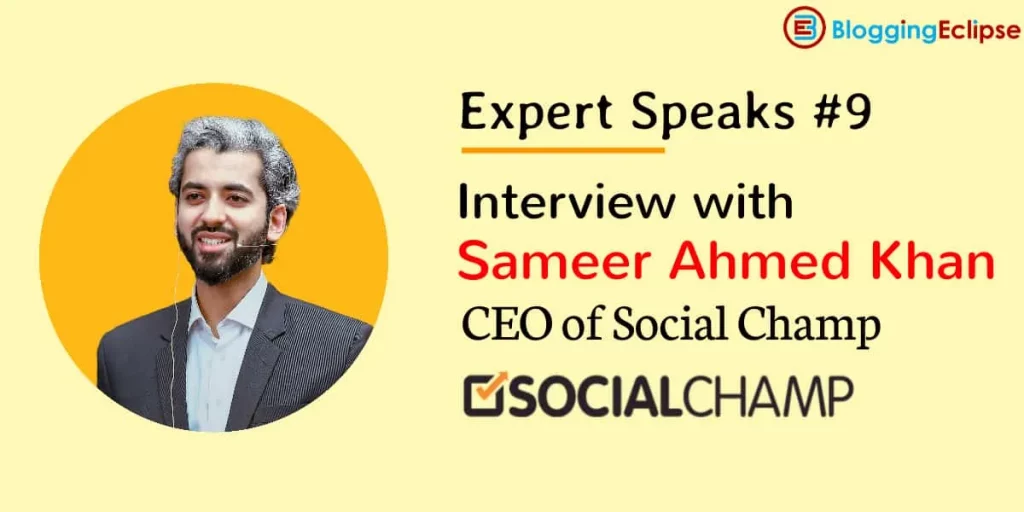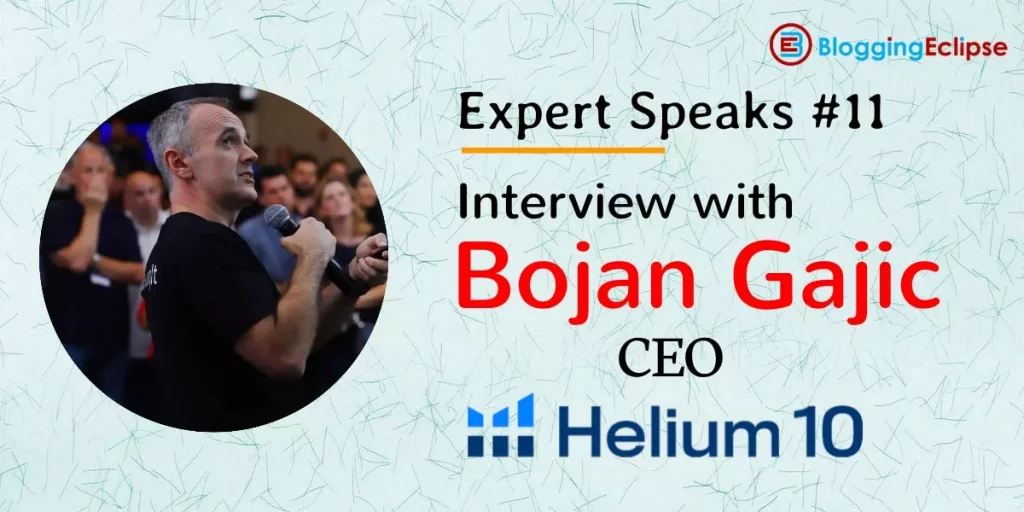It would be interesting if someone conducted a study on how different people use spreadsheets. The versatile design and easy-to-use nature of spreadsheets mean you can use them for any purpose imaginable.
“Imagine how you’d like to see data in your perfect application. Grist helps you build that,” says Dmitry Sagalovskiy, Co-Founder Grist Labs.
The issue is after a point, spreadsheets become so cluttered you can’t get any use out of the data you’re storing in them.
Coordinating between multiple spreadsheets and analyzing data points across them is a whole different challenge.
We at BloggingEclipse ourselves faced both of these problems motivating us to look for some project management software. We wanted something to create a functional database without letting go of the flexibility of spreadsheets.
After trying a lot of disappointing and expensive software, we found Grist. It filled the exact need we had, and the beauty of it is it can be modified to fill every exact need.

When we got a chance to talk to the co-founder of such an innovative app, we were not going to pass it up; what follows is a conversation on how Grist is the future of data analysis.
Q.1 Would you like to share some of your journey with us leading up to the creation of Grist?
I worked at Google on Google Sheets in its earlier days. Since I became quite handy with it, I set up a workflow for an education non-profit I later started. The power and flexibility of spreadsheets made it easy.
But as the project grew in the amount of data, complexity, and several collaborators, it started falling apart.
Some tasks became too time-consuming, some sheets too scary to touch, and some questions required poring through many sheets and became impractical to answer. But the spreadsheet was so close! Back then, I had to build a custom web app to replace our spreadsheets.
My brother Stan had a different perspective. He was working for a large financial company with no lack of money. They tried all kinds of fancy project management software. But none was flexible enough, so he found himself supplementing it with Excel anyway.
As we brainstormed, we knew that all such applications need a real database, but we kept coming back to the flexibility of spreadsheets. So the question became how to build that much flexibility on a database foundation and how to put that power into the hands of users. And it turns out it’s possible.
Q.2 How can users make use of Grist to make their workplace more efficient?
Pretend that you are designing the perfect custom application for yourself. You’ll have to figure out the many little pieces that make your application. So ask yourself what items of data relevant to you are.
That’s enough to get started with Grist: create a table for each item. Then create references to link different types of items to each other.
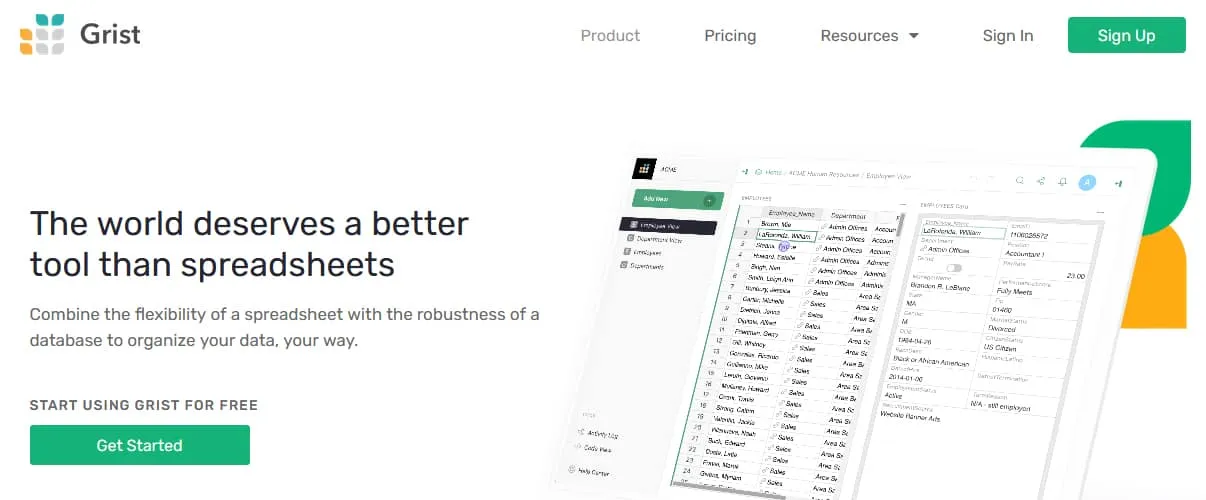
Now you have relational data — that’s very powerful! It lets you look at your data from different points of view.
Imagine how you’d like to see the data in your perfect application. Do you want to select a customer and see related contracts?
Create a page like that in Grist. Are you an affiliate marketer and want to select a product’s affiliate code and see income earned from it? Create a page like that. Do you want to see totals by month and select a month to see a breakdown by affiliate code? That’s just as easy.
A huge difference from spreadsheets is that you can make different views of the same data. You have one source of truth for all these views, not a bunch of copies that can get out of sync.
A valuable similarity to spreadsheets (and a difference from custom applications) is that you can start simple and add complexity bit by bit.
Maybe you use Grist to track your time and start with a single rate. Well, tomorrow, you can change it — add a column, tweak a formula — and you’ll have a different rate for each client. Then later, you’ll find that’s not quite enough; tweak it again to have a separate rate for each project.
You don’t have to start with the complete solution, and you can evolve your document with your needs.
Q.3 Do you think using tools like this can help users gain an edge over the competition?
Oh, absolutely. At its heart, Grist is a productivity tool. It’s important to have a good tool for the job. It’s frustrating to shop around, try different software, and find yourself too limited.
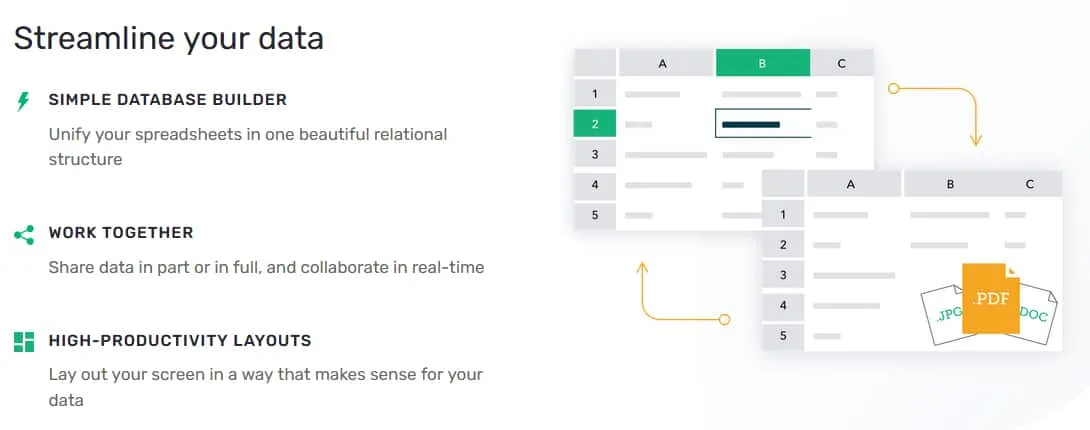
Really, that’s why people still end up using spreadsheets for business data. I understand why very well. But spreadsheets become very time-consuming. They can drain more time than they save.
Grist takes time to set up. If you are new to it, there is a learning curve. But it takes orders of magnitude less time than building a custom application. And that’s really what you get. The time you spend is creating structure, and Grist will keep that structure for you.
Unlike with a spreadsheet, you don’t have to maintain structure by hand, no copying formulas down or copying last month’s tab to a new one.
Once set up, you can forget that you are using Grist. The tool gets out of the way, and all you see is your data, and it represents real aspects of your business so that you can focus on those.
Q.4 How does that affect those who are just getting started and do not have the resources to purchase such tools?
Here is a little secret. The free individual plan that Grist offers is more powerful than most people realize. Yes, you are limited in the number of documents, but the truth is that you usually just need one.
And this document has full features — you can link all your data together, create all that structure and views and logic that I was talking about.
Because we allow some sharing even on the free plan, you can run a team of three people. Beyond that, yes, you need a team plan. That’s just $8/person/month. That’s a very low price.
I should mention that there is an even cheaper option because Grist is open source. So you can build and run it yourself. You need some technical expertise and a server, of course, so there are other costs. But the software really is free, so it’s a perfectly valid option.
Q.5 Is that part of the reason why you offer a free plan, Grist?
Yes. And also because so many people find spreadsheets useful outside of work. We think Grist is great for personal projects, and we are happy to let more people use it.

Ultimately, this is a benefit to us too. The more people use Grist outside of work, the more familiar they’ll be with what it can do, the more likely they will think of it when some need comes up at work.
That’s where paid plans come in, and that’s, of course, important for our bottom line. Once businesses solve their problems with Grist, they usually realize what a good deal they get even with our paid plan.
Q.6 Grist is unique in offering multiple ready-made templates for a multitude of common spreadsheet uses. Where do you plan to take the software from here?
Our templates are fairly new. There are many use cases not covered yet, so we are always working on more templates. Templates are really helpful to people to get started.
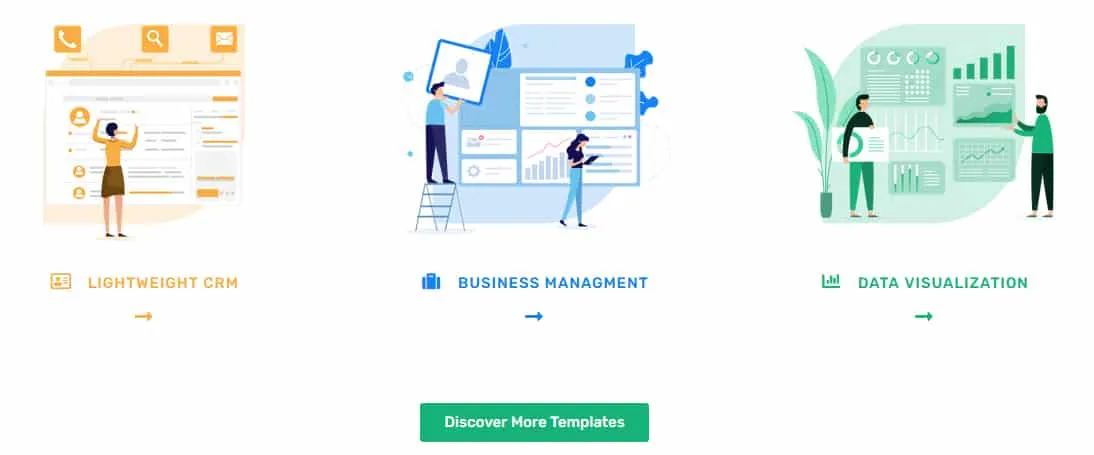
Occasionally, a template is just what someone is looking for. More often, people find a template that’s somewhat close to their needs. Then it serves to give them a leg up on that learning curve I mentioned. It’s much easier to tweak something close to what you need than to build from scratch.
But for the second part of the question — where we are planning to take the software — oh, we are pursuing so many directions.
We are working on making Grist easier to use. We are continuing to work on integrations. And on merging data during imports. And on improving access control options.
And on making custom widgets (a kind of extension that Grist supports) more powerful and easier to use. And on modernizing our Python data engine, hopefully leading to other exciting possibilities like supporting full-blown data science libraries in Grist.
These are just the biggest ideas being worked on, and they should allow Grist to become a fantastic solution for an even greater variety of use cases.
Q.7 Who are the users you’re looking to target, who can get the most value from your tool?
Our best users today, and our best target audience, are small businesses. These are a particularly good match for Grist, regardless of the vertical or type of business, because Grist brings many benefits of custom-built applications, which are usually out of reach for small businesses.
Over time our target audience will include larger businesses too. For now, it also includes a lot of individuals with side projects.
Some are for fun, like a book club, some are for personal trading or spending, and some are really just a kind of small business or seeds for a future business to come. I think these are all wonderful. It’s very exciting for me that our customers have such a wide range of use cases that they apply Grist to.
Q.8 The issues we face with spreadsheets are an everyday problem. What motivated you to formulate such an innovative solution to it?
Exactly that — that spreadsheets are an “everyday problem,” as you phrased it. I’ve talked to many people who spend all their day in spreadsheets, with a love-hate relationship, and they are eager to try anything else. The tools we use every day mustn’t create problems.

In a way, the solution is to “make an easy-to-use database.” That’s not very innovative on its own. There have been many attempts to make databases easy to use by non-developers. But I think Grist did manage to leave them behind in our focus on being more like a spreadsheet.
I’ve thought a lot about what makes spreadsheets so valuable and ubiquitous, and I think it is the sense that no matter what you need, this tool can let you get there one way or another with enough work. There is no limit to what you can do.
That’s the essence that I really value in Grist too. That’s why we are still putting effort into a full programming language as our formula language, or why our access rules have so much flexibility, or why we have an API and integrations and custom widgets.
Most of our users might not know Python and might not know what the “API” abbreviation stands for, but it’s important to know that as you get deeper and deeper into Grist, you can learn more and do more.
Q.9 How important is customer support to create a successful company?
It shocks me that there are companies out there that seem to be successful despite horrible customer support. To me, customer support is really important.
We are still small, and I answer many questions myself and do support calls too. I enjoy it, it’s really satisfying to help people, and that’s really how I learn who our customers are, how our product is used, what are the stumbling blocks, and so on.
And that, in turn, informs what we build and how we teach Grist — our documentation, templates, other educational materials.
Customer interactions are important too because ultimately, we are writing this software, not for computers but for people.
We are building Grist to make the world a better place. I am pretty sure that everyone working here has this sense — the sense that good software positively impacts people’s lives.
Software is so important in today’s world that it really affects things in good ways and bad. So building software that makes people more productive and happier and leads to fewer mistakes, that’s a worthwhile effort.
So we are writing this software for people, and to understand what people need, it’s important to have a dialog with your customers.
Q.10 Is there any plan to start an affiliate program for Grist?
Yes, there is! It’s early, so I don’t have details yet, but yes, we plan to start one.
Q.11 Does it often happen that the Grist team is using their software?
All the time! We are tracking projects, user feedback, hiring, even our cap table. We keep our internal CRM in Grist and populate it via the API from several sources. When we had a programming challenge for applicants to our software engineering job, we set it up to submit solutions to a Grist document.
Of course, it’s important to use the best tool for each job. We use various services. But sometimes, it’s still nice to keep a copy of the data in Grist — it makes it easier and quicker to see the big picture or to connect things from separate places.
Personally, I’ve been using Grist even longer, from well before Grist was working as well as it does now — for everything from my kids’ schedules to personal taxes. If I get a random CSV file, I open it in Grist. I really am more productive in it.
Q.12 How does one go about putting together the right team?
That’s a big challenge for any startup. I don’t have a formula that’s guaranteed to work. I feel incredibly lucky to have the team that we have now.
It was more than luck, of course — we have tried many different approaches, both to find talented people, attract them, and evaluate.
In earlier years, for hiring developers, I remember coming up with a puzzle, printing it on paper, and pasting it in the New York subway station near Google’s offices.
That didn’t work at all, though. This year, we came up with a fun programming challenge, and I think I did a good job filtering for experienced developers. I think it really helped.
For hiring non-developers, it’s even harder — I have less experience hiring for other roles. It’s good to have someone you can consult with, maybe ask them to interview or review a resume if it’s for a position you have little direct experience with.
It’s good to have a network of people who like you and trust you and whom you can trust too.
And if you are talking about starting a startup, don’t start one alone — have a partner who believes in the idea and is willing to commit to it.
That’s the advice I got before we started, and I took it, and I think it’s a good one. There are enough ups and downs in any startup that it’s hard to ride it out alone without the support of someone else.
Q.13 How would you explain the value Grist brings to amp up the workflow in any office to a manager?
It’s hard to answer such a question generically. I’d say — get the free plan or a team trial, and set up that workflow, even if it’s a simplified proof-of-concept.
If it’s better than what you have been using, your manager will realize it — here you have more visibility, there you can find the right data much faster, here you get a useful summary that’s always up to date. Make it specific to the company’s needs. Then it’s much easier to understand its benefits.
Of course, we try to describe the value of Grist generically on our website and in various marketing materials. It’s an easy-to-use database, and it’s powerful and flexible like a spreadsheet, and it’s easy to build things incrementally, and so on.
But I find that it always makes for a better conversation to talk about the business needs and how the tool can meet those.
Q.14 When work from home is the prevailing reality, how would you describe the impact of the pandemic on GristLabs?
In a way, the pandemic has pushed some people towards SaaS products in general. Some businesses that used to do things manually were forced to move online.
Some places used to do everything on this one computer in the office running some 30-year old software, and now that they needed to work from home, they had to find a cloud-based alternative. We’ve got some people moving from MS Access to Grist, for example. So Grist fits that bill quite well.
It was great to see Grist start getting used in a college classroom when the pandemic hit. The course taught basic database concepts, and they had to move from something installed in their computer labs to a database that any student could create and play within the browser.
So they found Grist and use it now to teach those concepts. I was very happy to see Grist used that way.
Q.15 Would you like to say a few words about BloggingEclipse before we wrap up?
It’s exciting that this interview happened because Ali of BloggingEclipse is using Grist himself and is happy with it. I am glad he found it!
As Grist itself aims for faster growth and wide adoption, affiliate marketing is becoming an indispensable strategy. We are very grateful to BloggingEclipse for being a helpful resource and an early partner!
It was fascinating to know the mindset which had crafted such an innovative platform. The upload schedule of this very interview will be coordinated in our team using a Grist sheet, and this is just one of the many ways we use Grist.
If you’re tired of scrolling through 10 different spreadsheets to get one data point and maintaining 12 related databases manually, stop pushing your and your team’s brains through the wringer and switch to Grist.
Its free-to-use plan can get you more functionality than any other project management software despite the paid version being extremely reasonable. Head on over to GetGrist.com and forget working with spreadsheets was ever frustrating.
Affiliate Disclosure: This post may contain some affiliate links, which means we may receive a commission if you purchase something that we recommend at no additional cost for you (none whatsoever!)



